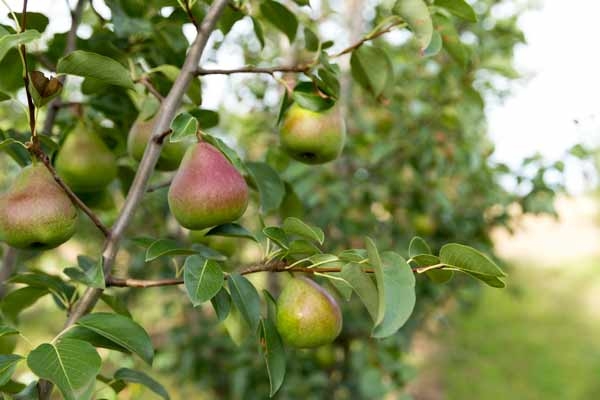In collaboration with Goulburn Valley pear growers, Agriculture Victoria researchers are conducting economic assessments of the new red-blushed pear ANP-0131 (Deliza®) to help growers determine how to grow it most profitably.
Bred out of the Australian National Pear Breeding Program at Agriculture Victoria, Tatura, and marketed by APAL as Deliza®, ANP-0131 is one of the new red-blushed pears that is visually attractive, tastes good, has desirable texture and stores extremely well, providing it with a point of difference on the fresh market.
Planting systems
The planting systems we are investigating at Tatura are characterised by high-density, compact trees that use water efficiently, fruit early in life and produce consistent high yields of quality pears.
We are examining thirty-six combinations of different training systems, rootstocks and tree spacing.
Training systems include single and multi-leader Open Tatura (OT) and vertical 2D designs, and central leader, spindle and vase 3D designs.
Rootstocks are Quince A (QA), D6 and BP1 and tree spacing ranges from 0.5 to 3m.
Assessing costs, benefits and risks
We are assessing the costs, benefits and risks of growing the new blushed pears on a representative block in a Goulburn Valley orchard using discounted cash flow analysis.
Potential advantages include more fresh fruit marketed at premium prices, earlier production to help repay the high establishment costs, and efficiencies in production and harvest operations at full bearing.
Initial focus
Our preliminary economic and financial assessment focused on trees grafted to QA rootstock and trained on Open Tatura trellis at densities of 1481 trees per hectare, 2222 and 4444 trees per hectare (respectively: 1.5; 1.0 and 0.5m between trees, all with rows 4.5m wide).
In order to establish a high density of fruiting units at a lower tree cost, the lower density plantings were trained with a greater number of leaders per tree (8, 4 and 2, respectively).
The results reflect actual establishment and tree training costs and yields achieved to-date in the experimental orchard at Tatura. These and other key assumptions are highlighted below.
Performance measures used
Economic performance was evaluated using discounted cash flow budgeting over a 30-year planning horizon. Performance metrics used were:
The net present value (NPV), estimated at a required (real) discount rate of 4.3%.
An NPV greater than zero indicates a potentially profitable investment.
The modified internal rate of return (MIRR), which is the discount rate at which the NPV is zero. It is the percentage return on the extra capital invested in growing the blushed pears.
Business risk was accommodated in the analysis through changes in farm-gate prices, yields, packouts and prices paid for water during each year over the planning horizon. A range of values were specified for these risky variables.
Financial performance was determined from the undiscounted (nominal) net cash flows (NCF) using the payback period; that is, the time (years) required for the investment in additional capital to break even.
Establishment and tree training costs
Establishment costs included ground preparation, trellis, irrigation infrastructure, trees and planting.
Netting for sun and hail protection was not included.
Establishment costs (Table 1) were highest for the higher density plantings, due to the additional cost of a greater number of trees and higher planting costs.
The variable labour inputs associated with tree training, tree support, leader management, winter pruning, tying down, thinning and summer pruning were high in the early years.
Tree training costs (Table 2) were considerably higher for the eight and four-leader lower density systems in year two. However, on a cumulative basis, costs were more even by the end of year three.
Labour was valued at about $23/hour in the analysis.
Price and yield assumptions
Orchard-gate prices were assumed higher, and fruit quality on average better and more uniform compared to the more traditional Packhams pear.
Based on a consumer preference survey and observed premiums for the parent cultivar (Corella) we assumed a price premium of 20 per cent for Deliza.
Continued next month
See this article & all Tables in Tree Fruit Feb 2016






















